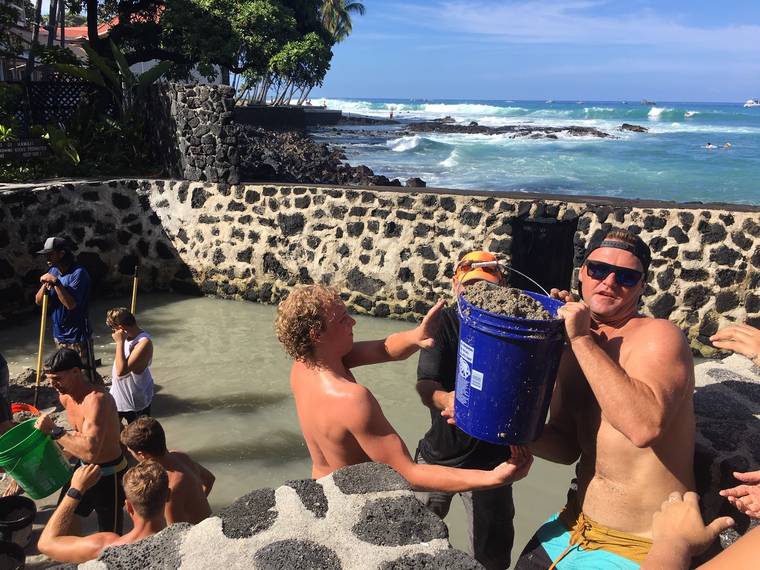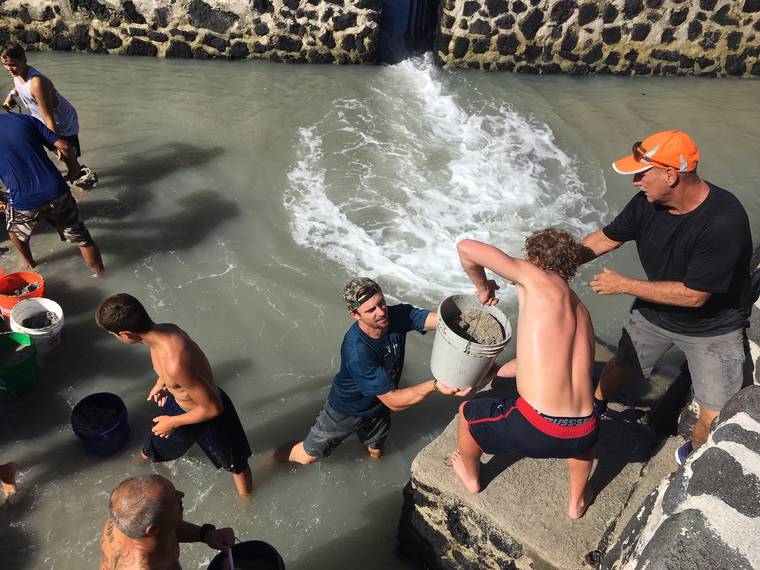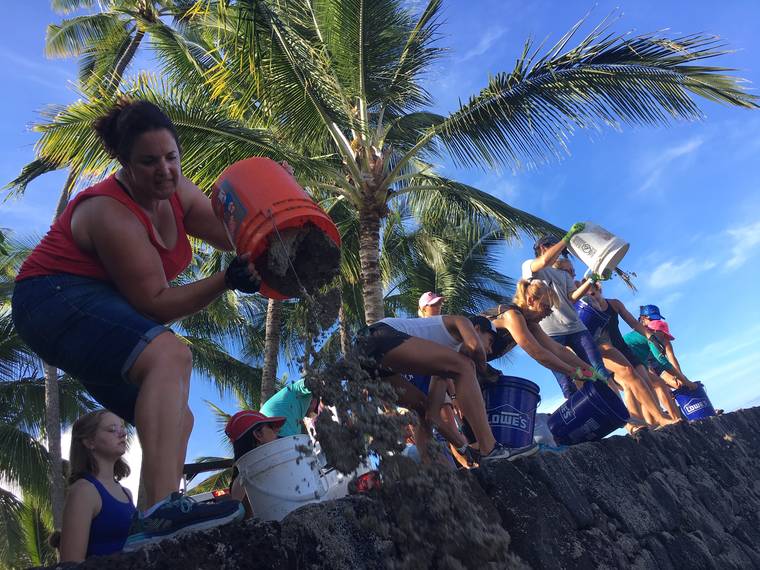KAILUA-KONA — The brigade of buckets moved up and down the line with tight precision, not much different than paddles cutting in sync through the water.
Inside those buckets was wet, heavy sand, built up from 20 years of surf and neglect, fouling the kiope pond and turning the former alii bathing hole into something closer to a clogged puddle.
But with muscle and teamwork — the latter component very important — Kai Opua Canoe Club paddlers spent their Sunday dredging untold pounds of sand up one line and down another in an effort to restore the cultural landmark to its former glory.
It was a project only sweat was going to fix.
“For me, this is a huge win for the club,” said Doug Vera Cruz, first-year Kai Opua club president, standing on the grounds of the Hulihee Palace where more than 100 strong, able-bodied paddlers worked under the morning sun. “That model of bridging the gap between culture and sport, to reintroduce lifestyle, is kind of the goal. And I think so far we’re doing a really good job.”
After two hours of work, the pile of sand in the pond flattened, and water rushed back in.
The sacred pond on the south end of the grounds was built with lava rock and coral mortar in the mid 1800s. It once served as a bathhouse for royal families. Fresh water empties into the ki‘ope pond through underground springs along edges of the wall. Because of its rich nutrients, it was later converted it into a fishpond.
Prior to Sunday, the pool that used to be 8 feet deep contained a resident eel and a fish or two.
“We’ve been dying to get this done forever,” said Manu Powers, fourth regent for the Daughters of Hawaii, the nonprofit that preserves heritage sites across the islands, including Hulihee Palace and the birthplace of Kamehameha III on Hawaii Island. “It’s been a very long process.”
Red tape trying to work on it through the state slowed any hope for quick progress.
In the meantime, Vera Cruz wanted the club to take on the project once more. Kai Opua used to clear it annually, before it fizzled out 20 years ago due to waning manpower and coordination.
But after a new burst of club gumption and a few months of hammering out details, a low-tide summer morning was selected and an old tradition was reinvented.
“It’s a club project so it’s kind of mandatory,” Vera Cruz said of his volunteers, who had the weekend off from racing in preparation for next weekend’s Aunty Maile/Moku O Hawaii championships in Hilo.
“It’s all hands on deck.”
Sun-tanned bodies formed a line from atop the seawall that snaked down into the pond. When buckets were filled, those arms, backs and shoulders passed them along the line into the bed of a waiting pickup truck. The truck drove across the grass to the northern seawall where a swell of paddlers unloaded them onto the beach below. There, the surf would pull the sand back into its abundance.
It was hot, heavy work in a cramped, unique space — something fancy machinery could not pull off.
“It was a little rough, but I was expecting it,” said Cam Villalobos, 15, who isn’t a paddler but volunteered for the project as a favor for his family friend, Vera Cruz.
It took a good 15 minutes getting the timing and coordination down of swinging and passing the buckets back and forth, but once they had the cadence locked, two hours went smoothly.
“I’m ready to eat,” he said.
James Resor, a Novice A paddler in his third season, said syncing the timing with his teammates in the sand was similar to in the canoe. It was a lot of work, he added, but all in a day’s training. Double training, that is. It warrants mentioning the men’s team practiced before the 7:30 a.m. project started. Still, there was no reason to claim fatigue.
“Not with your coach standing there with a shovel,” he said.
A lot of sand can build up in 20 years. Part of the pond’s damage and fill came from the 2011 tsunami that hit leeward Hawaii.
“Right now, it’s not even 2 feet deep so you can only imagine how much impacted sand is down there and rock,” remarked Lori Honl, Kai Opua board and Daughters of Hawaii member.
“It’s helping to restore what our alii had.”
At the end, with the project complete, it felt like crossing another finish line. The club plans on making it an annual event, just as it was in years past.
“This is our way we can give back, we can say thank you,” said coach Maile Leslie, who took part in the team effort that resembled a good old-fashioned sporting event. “You do what you’re good at. There is a place for everyone. Everyone was doing something.”











